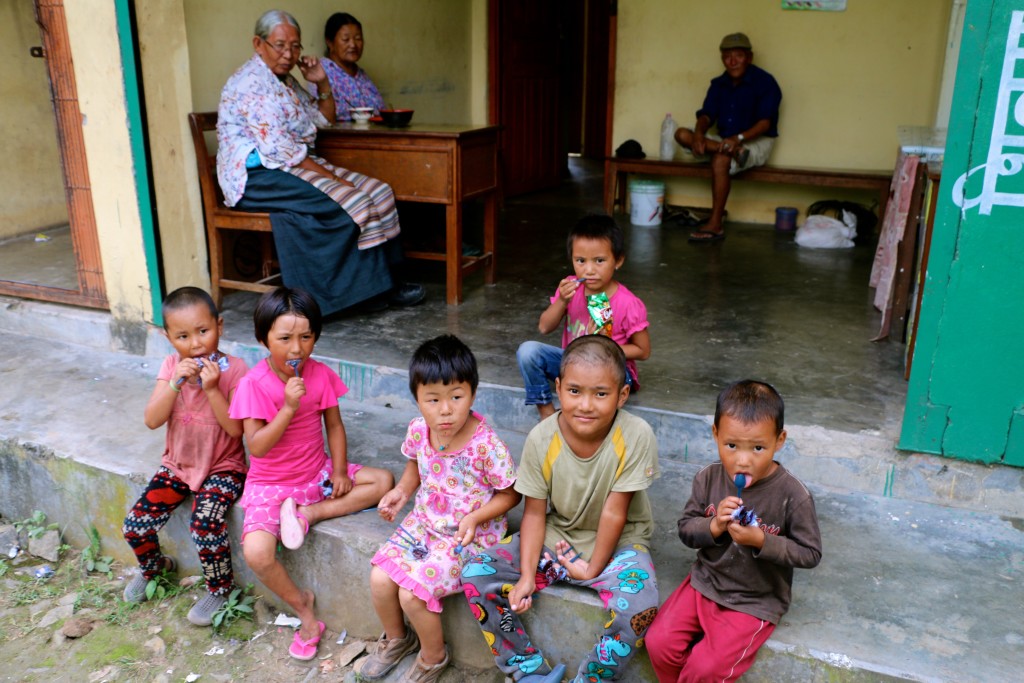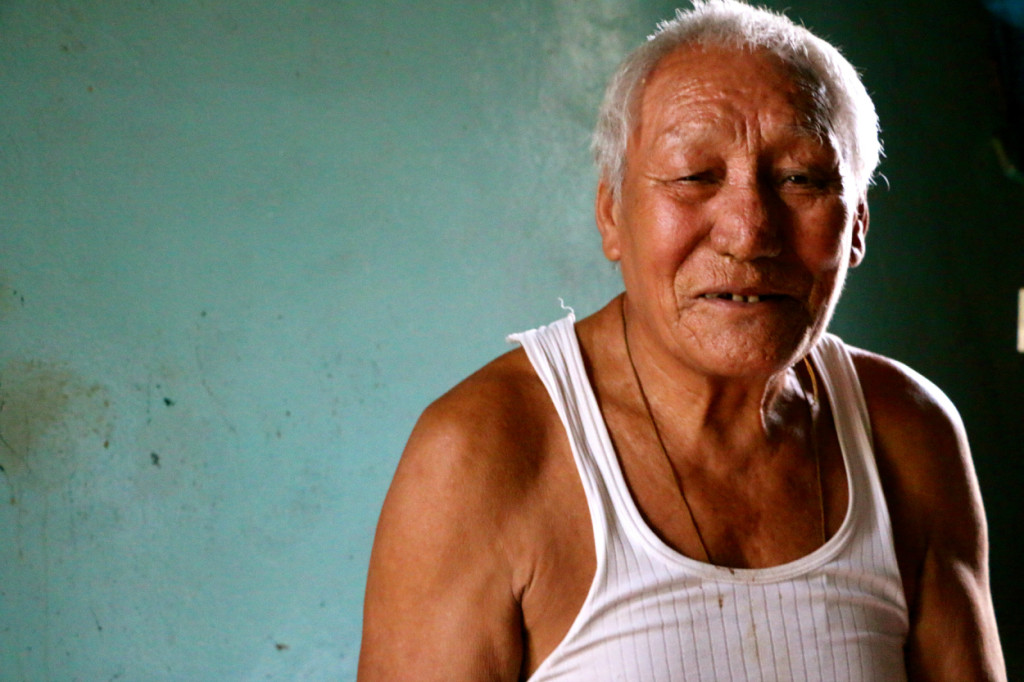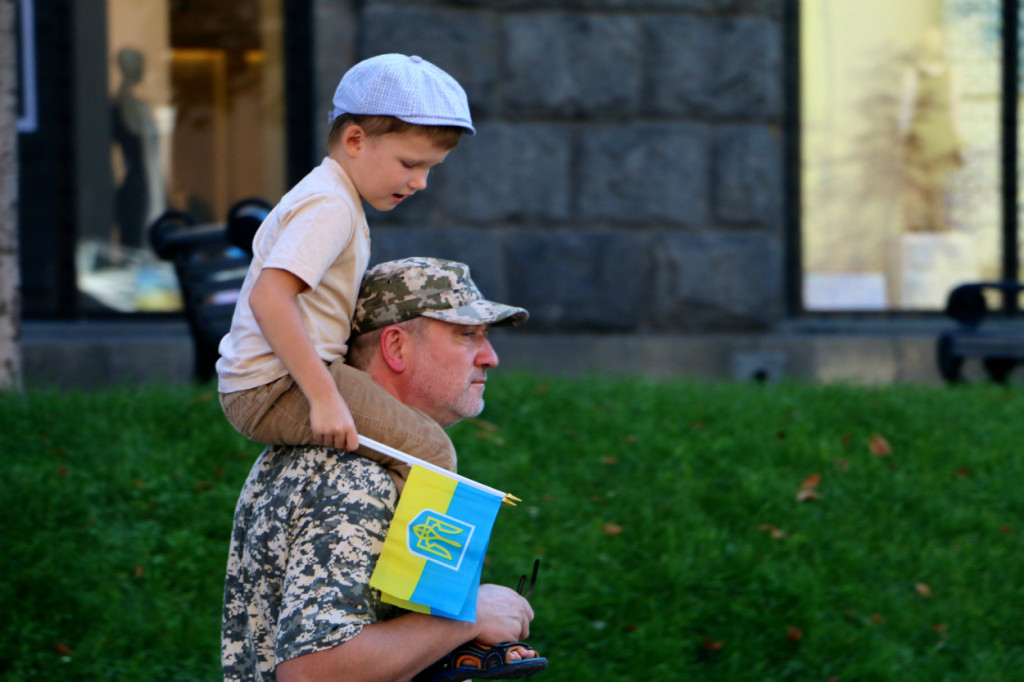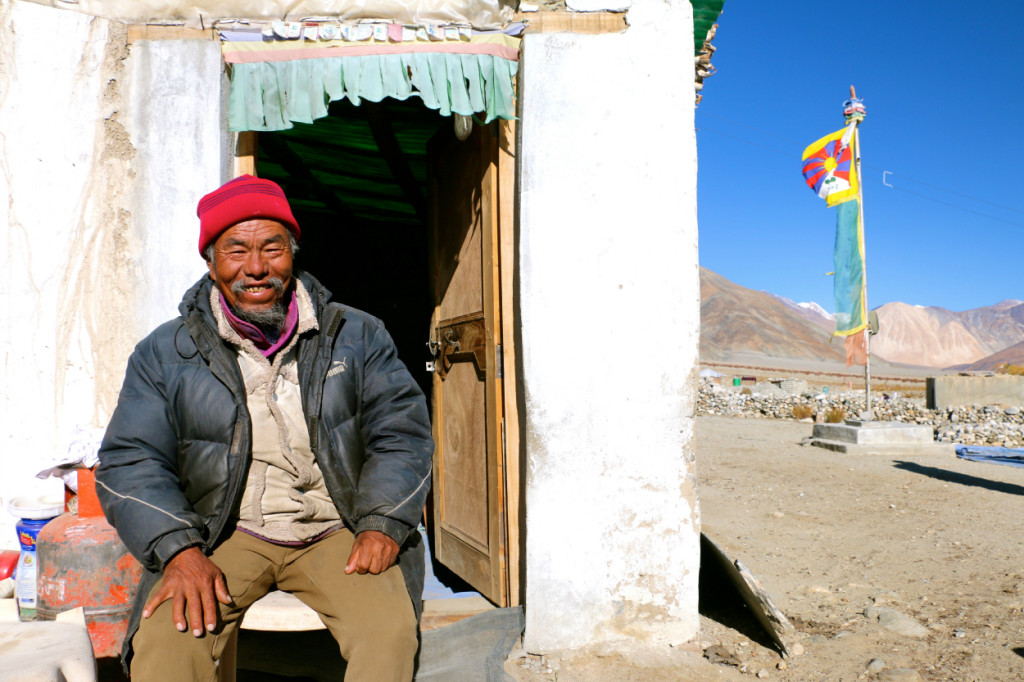What I Learned From Tibetan and Ukrainian Freedom Fighters
Nolan Peterson /
KATHMANDU, Nepal—About two months before a mortar killed him, 19-year-old Ukrainian soldier Daniel Kasyanenko smoked a cigarette with me in a trench in eastern Ukraine.
On that hot June afternoon, with random sniper potshots and artillery rounds comprising the background din, our conversation touched on many topics, most of which are not fit for print. But we also talked about freedom, and Kasyanenko explained to me why he had volunteered to go to war.
“We are fighting for our home and for our land,” Kasyanenko told me as we puffed on Marlboro reds. “Ukraine is a free country, and when Russia invaded I had no other choice. I had to fight.”
Four months later, 77-year-old Jampa Choejor offered me a cup of masala chai at his home in the Jampaling Tibetan refugee settlement outside Pokhara, Nepal. I was still slightly amped from the motorcycle ride it took to get from Pokhara to Jampaling—an hour-long slalom course dodging cows and overloaded buses on the free-for-all chaos of Nepal’s rural roads.

Tibetan refugees at the Jampaling settlement outside Pokhara, Nepal. (Photo: Nolan Peterson/The Daily Signal)
As we sat with legs folded on yak skin blankets while sipping our tea, Choejor, who is a former Buddhist monk, told me why he renounced his monastic vows in 1959 to join a Tibetan guerrilla army and fight Communist China.
“When the Chinese came, they raped women, they bullied, they killed,” Choejor said. “There was no freedom, no religion. After so many brutal acts, there was no way to stay silent. We had to fight. We couldn’t stay living like that.”
Choejor fought in the Tibetan resistance until 1974, when the Nepalese military rooted the guerrillas out of their mountain hideouts in the remote Mustang region on the border of Tibet and Nepal. Now Choejor lives in poverty. His worldly possessions comprise some threadbare clothes and a collection of old framed photographs of the Dalai Lama.
“We suffered in Mustang during the resistance,” he said. “But there was no other choice. The Chinese were killing so many people and things were getting so bad, we had to fight back.”
Throughlines of Two Wars
I spent one year reporting on the Ukraine war and the past month interviewing former Tibetan freedom fighters. Seemingly unrelated, common threads connect these two war stories, including this: When faced with the invasion of their homelands, many ordinary Tibetans and Ukrainians voluntarily took up arms and fought back.
“We’re fighting for freedom against Russia because they want to keep us under their control,” a 21-year-old Ukrainian National Guard volunteer, who went by the nom de guerre Grizzlo, told me from a trench outside the front-line town of Shyrokyne in April. Machine gun fire crackled in the distance.
“They want to take us in their control and we don’t like it,” Grizzlo said, cradling a Kalashnikov in his arms. “We are a freedom country and we are Ukraine and not some land of the Russian Federation.”
“I saw what China was doing in Tibet and it made me so angry, I had to fight, ” said Kelsang Tsering, 82, a former Buddhist monk who fought with the Tibetan resistance from 1955 until 1974.
We talked over the kitchen table in his home in the Jampaling refugee settlement. A flickering fluorescent lamp lit the room, and a picture of the Dalai Lama draped in a white Khata scarf was hung on the wall. Tsering’s wife sat on the floor, legs folded, spinning a prayer wheel and chanting a mantra.
“I’m still very angry,” Tsering said. “But I’m in no position to fight, I’m too old. My thinking is that the younger generation has a responsibility to secure our land. If I see young Tibetans fighting each other, I tell them the real enemy is on the other side of the mountains. If you’re really brave, go fight the Chinese.”
After the 1950 Chinese invasion, a Tibetan resistance army called the Chushi-Gangdruk began a fierce guerrilla war against China’s People’s Liberation Army. With CIA training and support, the Tibetan resistance fighters—many of them monks and nomads—fought for decades, ultimately laying down their arms in 1974 at the Dalai Lama’s behest.
(The CIA, coincidentally, used the same Polish bomber pilots to airdrop covert operatives into Tibet and Ukraine during the Cold War.)

Volodymyr, a Ukrainian sniper, preparing for a mission in Pisky. (Photo: Nolan Peterson/The Daily Signal)
A grassroots resistance campaign also took shape in Ukraine following Russia’s illegal seizure of Crimea and its invasion of the Donbas in spring 2014. (Because of the presence of Russian troops and weapons in Ukrainian territory, the word “invasion” is appropriate.)
Ukrainian civilian volunteer battalions played a key role in halting the advance of combined Russian-separatist forces, which initially overwhelmed Ukraine’s corruption-riddled regular army. The civilian soldiers, comprising men and women initially armed with hand-me-down police weapons, turned the tide of the Ukraine war.
The aggressors in these two conflicts, China and Russia, justified their invasions by challenging the historic legitimacy of their victim’s sovereignty. They also claimed a paranoid fiction (or shrewdly used propaganda to exploit cultural and historical stereotypes) about “liberating” the invaded country from imperialist Western influence.
Reality, however, paints a much different picture than that offered by Beijing or Moscow.
Austrian mountaineer Heinrich Harrer says there were five Westerners in all of Tibet when China invaded in 1950. (Despite 1.2 million Tibetans killed during China’s invasion and occupation, China still calls it a “peaceful liberation.”)
And the 2014 Maidan revolution in Ukraine was not a CIA-backed, neo-Nazi coup as Kremlin mouthpieces have suggested. It was a grassroots reaction by Ukrainians across all spectra of society against the corruption and abuses of the pro-Russian regime of Viktor Yanukovych.
While Ukraine and Tibet tend to fade from the headlines, these Cold War battlegrounds remain modern flashpoints. Sixty-five years after “liberating” Tibet, China’s Communist Party fears a revolt in the Tibet Autonomous Region could spark wider anti-government protests, perhaps even revolution. Consequently, China has turned Tibet into a nightmarish Gestapo state for the Tibetans living there.
China’s attitude toward the Dalai Lama is revealing. In 2008, Zhang Qingli, then the Communist Party chief of the Tibet Autonomous Region, called the Dalai Lama “a wolf in monk’s robes, a devil with a human face but the heart of a beast.”
And after Ukraine’s westward-looking 2014 revolution, Russia seized Crimea and invaded the Donbas in what many analysts and politicians say was a Kremlin gambit to reassert power within its “sphere of influence,” i.e., the former Soviet Union.
America’s old Cold War foes have reemerged as contemporary military threats, highlighting what some fear is a global order teetering ever closer to catastrophe. Russia’s involvement in the Syrian war has put its soldiers and warplanes dangerously close to U.S. forces in the region. And as a reaction to Russia’s war in Ukraine, U.S. warplanes and ground forces have been repositioned farther east in Europe to reassure anxious NATO allies and deter further Russian aggression.
Tensions between the U.S. and China also are increasing—edging closer toward war, some fear. When the warship USS Lassen sailed within 12 nautical miles of two of China’s man-made islands in the South China Sea on Oct. 27, China accused the U.S. of provocative acts that could lead to conflict. U.S. officials countered that the destroyer was sailing under freedom of navigation boundaries recognized by international law.
“The U.S. finds itself today in a post-Cold War global order under immense strain, even in partial collapse,” Wall Street Journal foreign affairs columnist Bret Stephens writes. “ … In Asia, China has proved to be, by turns, assertive, reckless and insecure. Russia seeks to dominate its neighbors through local proxies, dirty tricks and even outright conquest.”
Duty and Humility
Throughout my time on the front lines in Ukraine and during my visits to Tibetan refugee colonies in India and Nepal, I’ve looked for answers to a simple, but essential question: What spurs an ordinary man or woman to cast aside all selfish interests and risk his or her life for the greater good?
Unfortunately, simply asking a freedom fighter why he or she fights is usually less than illuminating. They are frequently so nonchalant about what they’ve done that their explanations fall short of any meaningful introspection. Yet, their humility offers an insight into their motivations. Above all, they fight because they believe it is their duty.
“I don’t think I’ve accomplished something big, but I feel satisfied,” said Lopsang Chombel, 84, a former Tibetan monk who took up arms to help the Dalai Lama escape Tibet in 1959 and who went on to serve with the Tibetan resistance in Mustang until 1974.
“I did everything honestly and truthfully when my country needed me,” he said.
For many of the Ukrainian and Tibetan freedom fighters I’ve met, their decision to fight wasn’t really a decision at all. Their country was invaded, innocent people were dying, and so they had to fight.
It’s simple arithmetic. It’s not romantic or idealistic, although to an outsider it seems that way. Their decision to serve was no more under their control than a balloon in the wind. They reacted to the injustices to which they bore witness the only way they possibly could—by fighting back.
“It’s impossible not to be motivated when the enemy has attacked the motherland,” Ukrainian volunteer soldier Vasiliy Ivaskiv, 53, said as he cooked breakfast in a basement artillery shelter in Pisky, Ukraine.

Ukrainian civilian volunteer soldiers training outside Kyiv. (Photo: Nolan Peterson/The Daily Signal)
Pisky is a front-line town in eastern Ukraine, just outside the Stalingrad-like ruins of the Donetsk airport. When I was last there in June, the artillery-ravaged town was almost completely abandoned. Only few stalwart citizens remained, as well as the Ukrainian regular army’s 93rd Brigade, which was scattered throughout basement shelters and a network of fortified trenches.
Ivaskiv, a former miner from the western Ukrainian town of Ivano-Frankivsk, called me “Amerika” and had a habit (despite my protests) of using his body to shield me from sniper fire. Compact and muscular, Ivaskiv exuded energy, leading daylong patrols of men less than half his age. But he was also a father figure. He always seemed to be fixing something and usually did the cooking. He also occasionally scolded younger soldiers for being incautious or lacking discipline.
Ivaskiv volunteered to serve in the Ukrainian army after a few trips to deliver supplies to front-line troops in the early days of the war. “I saw those young men fighting and dying for Ukraine, and I knew I had to fight too,” he told me, proudly adding that his father had fought the Nazis in World War II.
When he left for war, Ivaskiv said he had to step over his wife, who was in a heap in the doorway, sobbing and pleading for him not to leave.
“There was nothing she could do to stop me,” he said. “I had to go.”
On Killing
I asked Choejor how he made the mental leap from being a Buddhist monk, for whom all killing—even of insects—is forbidden, to becoming a soldier who had killed Chinese soldiers in hand-to-hand combat.
“In the beginning, I was thinking we were monks, and so we shouldn’t kill,” he explained. “But when I recalled all the abuses, all the terrible things the Chinese did, I forgot my hesitation to killing. After seeing so many bad things, I forgot that killing was a sin. I was hoping to kill, and I felt happier the more I did it.”
“I felt no hesitation to kill,” Tsering replied when I asked whether being a monk made him reluctant to take a life. “They were killing our own people. For the sake of our country and our own people, I did not hesitate at all. Fighting back was the right thing to do.”
“We killed a lot more Chinese than they of us,” Chombel said. “But no matter how many we killed, the next day there were more. They were like ants.”
Standing in a trench in Shyrokyne on a blustery April day only about 500 meters from combined Russian-separatist positions—close enough to hear their voices—I asked Grizzlo whether living for months across the narrow spread of no man’s land from the enemy had made it harder to kill. I wondered: Had the proximity humanized the enemy?
“For me, it’s not so hard,” Grizzlo told me. “Our enemy, the Russians, they’re like animals. … I like fighting in the streets when the distance is very short. It’s a real war when you can see your enemy in your eyes, and see the eyes of your enemy.”
“We have to fight them here because they won’t stop,” a 28-year-old Ukrainian sniper named Volodymyr told me in Pisky. He used to work at an Obolon beer factory and had a wife and young child at home. He believed that if the Ukrainian army left its positions in the Donbas, combined Russian-separatist forces would keep advancing, maybe going as far as his hometown in the West.
“I never hesitate to shoot,” he said. “And I never feel regret.”

Jampa Choejor fought with the Tibetan resistance until 1974. (Photo: Nolan Peterson/The Daily Signal)
Tibetan and Ukrainian freedom fighters’ moral certitude about the justice of killing parallels an absolute commitment to their cause, which stems from defending their homeland. “We never thought about retreat, we were totally prepared to die,” Choejor said. “We thought: ‘We were born here. If we have to die, then we will die here.’”
“We didn’t worry about dying,” Chombel said. “We just wanted to fight the Chinese. We were committed to go into battle; that was the only way to get our country back.”
“Take our guns and go home? We can’t do this, we don’t like it,” Grizzlo said. He was a 21-year-old platoon commander in charge of 21 soldiers. Yet, like many Ukrainian volunteers, he received almost no training before going into combat. He said that he and his men were constantly “studying” how to fight a war.
“There, we have our land,” Grizzlo said, pointing toward territory controlled by combined Russian and separatist forces. “Two kilometers in front we have our land, 10 kilometers in front we have our land, and 20 kilometers and 30, 40, 50 kilometers—it’s all our land. It’s Ukraine. And in all this territory we have enemy. So we wanna fight.”
Freedom Is Not Free
The day I first arrived in Ukraine in August 2014, I visited the Maidan, which is Kyiv’s central square and the epicenter of the 2014 revolution. There were still bullet holes in the sidewalks and street signs at the top of Institutskaya Street where pro-regime snipers had gunned down protesters the preceding February.
When I visited, the area was covered in beds of flowers and candles surrounding framed photographs of the more than 100 protesters who died. The faces of the fallen included the young and old, men and women. As I walked around, trying to appreciate what had happened there six months earlier, I heard an American voice, which stood out from the Russian and Ukrainian ones, say: “Freedom is not free.”
Admittedly, that’s somewhat of a trite, jingoistic thing to say in America—typically heard around holidays such as Memorial Day and the Fourth of July. There’s even a spoof song in the movie “Team America” called “Freedom Isn’t Free” (with strong hints of Lee Greenwood). Yet, when I heard those words in Kyiv, with the scars of the revolution visible all around me, their meaning truly stuck.
I thought about those words almost eight months later as I stood on an artillery-cratered beach in Shyrokyne and spoke with Ivan Kharkiv, a 20-year-old journalism student who had volunteered to fight with the Ukrainian National Guard Azov Battalion.
“Peace is possible, but Ukraine must be a free country,” Kharkiv said. “We must free our territories and then we can live in peace.”
Freedom is not free. I was still thinking about those words last month, when I met Tsering Tunduk, 70, who lives on the Indian shore of Pangong Lake in the remote Ladakh Himalayas. The shoreline opposite Tunduk’s home is Tibet, the homeland from which he fled in 1959 after Chinese soldiers executed his parents, forcing him and his little sister, Khunda, to watch. He was 14 years old at the time.
Years later, seeking revenge for his parents’ murder, Tunduk joined a secret, CIA-backed all-Tibetan unit in the Indian army called Establishment 22, which was created to fight the Chinese in the Himalayas. He served for 27 years and saw combat in several conflicts against Pakistan. But he never fought the Chinese.
“It was frustrating to fight in someone else’s wars,” he said. “Personally, I was always fighting for Tibet, not for India.”
Now Tunduk lives as a nomad on the roof of the world, like his parents did. He hasn’t returned to Tibet since 1959, and he admits that at 70 he probably never will. But he still believes that Tibet will be free one day.
“Every being has a birthplace, a place where they dream of going back to,” he said. “My identity is Tibetan. Until death we will want our country back.”
Freedom is not free. I’ve met many people over the past year whose lives symbolize that truth. Like Oxana Chornaya, 35, a university professor who put her life on hold when the Ukraine war began so she could deliver supplies to Ukrainian troops on the front lines. She wore body armor over her floral sundresses as she weaved an old, fully loaded minivan through artillery fire.
“Sometimes I’m so afraid I can’t take my hands off the steering wheel,” she told me during an interview in Kyiv. “I get so scared. My knuckles are white and I can’t breathe.
“But I have to do this,” she said.
And Lhasang Tsering, 68, a former Tibetan guerrilla fighter who served in Mustang. He turned down an opportunity to pursue medical school at Johns Hopkins University to join the Tibetan resistance (a decision for which the Dalai Lama personally scolded him).
While Tsering was in high school in India, a Reader’s Digest story about the Tibetan resistance in Mustang inspired him. He explained: “I said to myself, ‘Good God, these guys are fighting, and if we younger Tibetans don’t fight, how will the resistance continue?’”
He now lives in Dharamshala, India, where he owns a bookshop, but Tsering’s commitment to Tibet’s independence hasn’t wavered.
“In my view, achieving freedom comes first,” he said. “I decided then that I was going to dedicate my life to the freedom struggle. And I am still ready to die for independence.”
Worth the Fighting
The price of freedom is usually set by those who try to destroy it. Yet, despite the Russian tanks and the Chinese pogroms, Ukrainians and Tibetans still believe freedom is worth the fighting for.
Perhaps freedom simply means more to people who have experienced the alternative. When I asked whether he would ever go back to Tibet, Chombel replied: “Not without the Dalai Lama.”
“If I go back before Tibet is free, it’s a kind of surrender,” the 84-year-old former monk and freedom fighter explained. “I’m still very optimistic Tibet will be free again one day. If I were younger, I’d go back and fight. But I’m old and will die soon, and now it’s up to the younger generation.”

Many Ukrainian civilians volunteered for military service after the conflict began in spring 2014. (Photo: Nolan Peterson/The Daily Signal)
“Ukraine is our country,” Grizzlo told me in the trenches in Shyrokyne. “We are free, and we will fight for our freedoms like our fathers and our grandfathers.”
Freedom is not free. Those words and what they truly mean echoed in my mind when I received an email Aug. 7 from my friend Virginie, a French journalist, informing me that a mortar had killed Daniel Kasyanenko on a battlefield in eastern Ukraine.
“I remember he told us that war is a bitch and that he wanted to go home,” she wrote. “Bloody war. Although we know he’s a soldier and that can happen, sometimes it’s really unfair. … He was just 19.”

